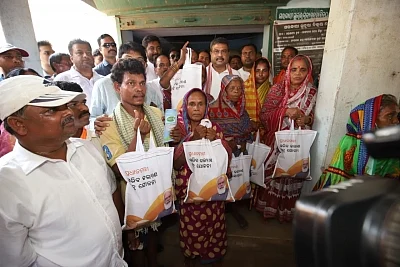Being affluent, I am on a diet, fasting for 19 hours at a stretch, eating within the remaining five-hour window, and keeping my calories under 800 per day. These are the luxuries of the rich. The poor, who earn their living through hard, back-breaking labour, cannot afford to go hungry. And to survive, they need the Pradhan Mantri Garib Kalyan Anna Yojana, which has just been extended for another three months.
In fact, India’s poor need it to be extended in perpetuity. Let me explain why.
Do The Poor Continue To Remain Undernourished?
Manual workers need at least 3,000 calories a day if they do heavy work, and at least 2,700 calories a day if they do moderate labour. The government’s Expert Committee set up by the Ministry of Labour and Employment in 2019, sets a lower average calorie consumption target of 2,400 per day.
Of course, this average includes people like me who lead a largely sedentary life and need much less.
What is important is that the committee recommended that people eat at least 50 grams of proteins and 30 grams of fat per day. That means, a manual worker would still need at least 2,200-2,500 calories a day from carbohydrates, such as foodgrain, sugars and carb-rich vegetables and legumes.
Inadequate Subsidies Lead to Skipped Meals
In reality, India’s poor have very little access to proteins and fats, and get most of their calories from cereals and tubers. If they had to get 2,500 calories from rice, they would need at least 650 grams per day. If it were a family of five with varying calorie needs, one could assume that they would need at least three kilos of rice per day, or about 90 kilos per month.
How much would that cost if they had to buy it at real, non-subsidised, market prices? Not less than Rs 3,500-4,000 per month. That is just to buy rice. Nothing else. Add basic things like potatoes, onions, edible oil, a small amount of pulses, salt, spices, cooking fuel and it comes to a minimum of Rs 5,500 per month for a very basic calorie-sufficient yet not a nutritious meal for a family of five.
Now, let us assume that the family spends two-thirds of its income on food. That would mean that a family of five which can afford to spend Rs.5,500 per month on meals will need to have a monthly household income of about Rs 8,333.
How many families in rural India earn less than that? There is no data for the latest period, but National Bank for Agriculture and Rural Development (NABARD)’s last All India Rural Financial Inclusion Survey (NAFIS) done in 2018-19 tells us that 70% of rural households earned less than the stipulated amount per month.
If one excludes richer states like Punjab, Haryana and Kerala, that proportion would easily rise to 80% or more. So, 70-80% of India’s rural households cannot afford to buy food at market prices. If they didn’t get heavily subsidised foodgrain, they would go without meals more often than they already do.
Will Free Ration Feed the Nation?
On an average, a working-class Indian needs 18 kgs of rice per month. Out of this, they now get 10 kgs for about Rs 150. They still have to go to the open market to get the remaining eight kgs, for which they have to pay between Rs 300-320. So, thanks to the government's subsidised food scheme, a family of five can get enough rice by spending about Rs 2,250-2,350. If they keep rest of their expenses to the bare minimum, they can survive on Rs 3,500 per month.
Note that, NAFIS 2018-19 tells us that 30% of rural families earned less than that threshold. If we assume that nominal incomes have risen since then, one could say that about 25% of the poorest rural households earn less than R .3,500 per month.
This means that even with the current food subsidy scheme, we can expect one-fourth of the rural population to go hungry.
So, not only do we need the free ration for an overwhelming majority of Indians but also much more for the 80 crore to get covered – especially those at the bottom of the pyramid need more than what is being given right now.
Will Portion Control Help India’s Poor?
This is one part of the story. As I have said earlier, poor people in our country get most of their calories from rice, wheat and other coarse grains. The government's own committee says they should ideally consume 50 grams of proteins and 30 grams of fats every day.
About half of the protein requirement would come from the large quantities of rice being consumed; half a cup of boiled daal would give 9 grams, one egg can provide about 6 grams, one cup of milk another 8 grams.
In other words, a family of five would get enough nutrition if they were provided 5 kg of pulses, 30 litres of milk, and 5 kgs of edible oil. This works out to a per-capita eligibility of one kg of pulses, six litres of milk and one kg of edible oil.
We don’t need less subsidy, in fact, we need more. So, the next time you get a viral forward on your family WhatsApp group about how the free-food scheme is a colossal waste of the tax payer's money and needs to end because it is making the poor lazy, think twice before suggesting such drivel to some other Marie Antoinette of India’s upper-middle class.
(The author was Senior Managing Editor, NDTV India & NDTV Profit. He now runs the independent YouTube channel ‘Desi Democracy’. He tweets @AunindyoC. This is an opinion piece. The views expressed above are the author’s own. The Quint neither endorses nor is responsible for them.)
